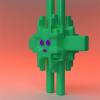Search the Community
Showing results for tags 'Symbols'.
-
Is there a keyboard shortcut for adding math symbols such as the degree symbol. So far, I have only found the insert, math, degree 3 step method?
-
You may have seen this video on YouTube about Affinity Publisher Beta v. Adobe InDesign. which is in my opinion a massive fail. Affinity Publisher isn't a copy of of InDesign. It's a different operation concept. Think different! I really like what I've seen and tested so far in APub - very good job! To solve the problem of the video I've nested picture frames inside the beautiful symbols and with one click you've added a picture to all linked triangles as shown in this demonstration: https://drive.google.com/uc?id=1x5G9JD5bLlmhiIYhQWnAoigEL1Q7LhZx Keep on drawin' Norbert
-
If a symbol line/fill/effect colour is from a document palette, and that colour is edited, and then the edit undone: the colour of the symbol remains the new colour and is no longer linked to the palette. While hapening most of the time, it does not appear to be consistent, so more than one attempt to replicate the bug may be necessary. Edit: further testing suggests the symbol colour is still linked to the document palette. After replicating the bug, and leaving the symbol with the wrong colour, editing the fill a second time is reflected in the symbol.
-
Good afternoon people; I believe that, like me, everyone who makes patterns in Affinity uses the method to create Symbols > transform into Assets. At first I found it strange, but nowadays I confess that I prefer this than other software methods, especially by the easy editing of the Symbols tool. My only problem would be this: when it comes to replicating this as Assets, sometimes it's kind of annoying. I would suggest to the Affinity Group a Frame Tool option, similar to that of the Text Tool to facilitate the creation of Patterns. Something like that: the user selects his Asset as an individual object or a Frame; if the user chooses as a Frame, it selects the applied area and, as a result, the Tool replicates as many times as necessary to the appropriate size within the Frame Area. I made this horrible drawing/print to demonstrate, using the Frame Text to show something like I was thinking. Thanks guys, you're incredible.
-
Hi, if I’m copy any item/shape/img etc. with a symbols binding and paste it to other document AD crashes. Example in attachment video. RPReplay_Final1560869313.MP4
-
Hey everyone! This feature request is for macOS as well as for iPad. It's great nested symbols is implemented now. I have a suggestion that would make things easier to see what's going on: It would be useful if there were different symbol indicator colors depending on symbol nesting depth. For example: Normal symbol: Orange Symbol that holds symbol(s): Yellow Symbol that holds symbol(s) that hold(s) symbol(s): Green ..... Blue ..... Pink ..... Purple ..... Red Best wishes, Shu
-
Moin, Is there an easier way to archive the result shown below? The effect (blur) should only affect a part of the picture. It should work dynamically so you don’t must update the image manually and get problems with the alignment. If there is no other way - can you please implement symbols to Publisher? I had to create a symbol in Designer and copy & paste it to Pub. The feature would also make it a lot easier to mask out parts from a background and bring them on top over some text... but it would work that easy because you still have to adjust the mask after moving the picture... we probably need another solution for this. --- (just noticed it now... u can keep the second "t" maybe u can use it la[ ]er) Lg Marc Henry dynamic pictures.afpub
-
- symbols
- dynamically
-
(and 3 more)
Tagged with:
-
I cut and paste some symbols from Affinity Designer into Affinity Publisher, but could not detach them in Affinity Publisher. Does anyone know if the Symbols studio is going to be included with Affinity Publisher?
-
As a interface designer I'd like to create a styleguide document with all my components / symbols and reuse them in different documents / interfaces. - When opening a document with linked symbols, the symbols should get updated to the most recent state (or give me a prompt to do so). Why not everything in one document? Complex interfaces can easily have more than 100 screens / artboards and organizing them in 1 file get's messy.
-
As a user I like to define symbols and then alter the text of the instances. This would vastely improve the reusability of symbols. (See Adobe XD, Gravit Designer)
-
I appreciate that Affinity Designer has symbols, but the feature is still very bare bones. To make it more usefull in case of. f.e. interface design, symbols with states would be very helpful. Usecase Design a navigation with highlighted items. You don't want to have a single navigation symbol for each state. Instead you want to design your navigation once and reuse it in all the subpages of your interface, ensuring a consistent style across your project. Solution A The user can define states in the symbol. This could be an initial, hover and active state for a button. Or the active items of a navigation. When using the symbol, the user can select the state of the symbol. (See Photoshop with layer compositions in smart objects, or Sketch) Solution B The user can create layers and folders in the symbol. The visibility of these layers can be toggled when using the symbol. In the case of a navigation, the user can create an active state for each navigation item. When using the symbol, he only makes the current active item visible. (See Gravit Designer)
-
Hi all, I've started digging into Affinity Designer to design a board game and feel like it's behavior is inconsistent, or maybe I don't know how to use the tools. I am working on a board game, and currently working on cards. I have an Artboard that contains a layout for a card type, and within that board is the card background which is a Symbol, that contains shapes. I've pasted multiple instances of the card background Symbol onto another Artboard (for printing), which is where I overlay the card text and values. When building some iconography for the card, I have two icons that I Group together, and then make another Symbol. When I drag that symbol into the card background Symbol, it does not update the other instances of the symbol. However, if I ungroup the iconography symbol, the card background symbol updates with the icons, and the iconography Symbol updates in the Symbol browser as empty. I just don't understand the behavior. Can Groups not be symbols? I really need the Group to stay intact, because I want the distances of that iconography symbol to be persisted across all the cards. I've uploaded a movie to help with the issue. symbol-issue.mov
-
hello i have just downloaded the program and starting to learn seems a great program so far i have ordered the work book awaiting delivery and have watched lots on youtube but one thing i cant find is what these symbols/items are for i have looked in the forums but cant spot the answer thanks very much Paul its the items circled
-
Hey everyone! It would be useful to be able to name symbols. Best wishes, Shu
-
Issue / Task: Imagine you are creating a user interface or some other dynamic / modular design consisting of a variety of elements, sharing certain properties, such as color stroke width fx and many more Possible Applications: Creating dynamic, unified color palettes for multiple buttons, knobs, input fields etc. Changing global or semi-global stroke properties on the fly Re-using existing designs while applying new schemes for a new entry in the series swiftly Speeding up changes to large-scale projects in general Related Solutions: While Symbols allow for document-wide changes in properties within copies of the same object or shape, when working with a diverse range of shapes, groups and nestings can be tedious to impossible. Inheritances would speed up things considerably and add a whole range of possibilities. Implementation Suggestion: I would imagine the following workflow to be quite effective and straightforward, at least as far as my routine is concerned: Select and copy the source element Select the element to inherit a property Navigate to a window / tab with any property (such as color, stroke, fx etc.) Click the Inherit Button, a small, universal icon found in all studio tabs and windows. This property is now linked to the source element. Changing this specific property within the source element also affects this element. Click the Inherit Button again to unlink / disable the inheritance. Copying elements with an inheritance would preserve the inheritance for the copied element. I hope this makes reasonnable sense - of course I would be thrilled to find out something similar was already available in Affinity Designer. Cheers!
- 2 replies
-
- inheritance
- parent
-
(and 8 more)
Tagged with:
-
Hello, This is frustrating and a bit hard to describe. It is probably clearest if you watch the video I've made: The setup is that I have multiple artboards of different aspect ratios and sizes. Then I've made a symbol (the blue background rectangle) and added an instance of it to every artboard, sized to fill the artboard. I then proceed to select an instance of the symbol, with sync enabled, and insert an object into the symbol --- first an image, and then a rectangle. As expected, the object is populated into all the symbol instances (yay!), but the aspect ratios/orientations of each instance seem to be ignored - so it looks skewed on the portrait artboards. I'm struggling to properly articulate the behaviour here, but hopefully the video makes it clearer. I do understand why this is happening I think - it seems only the orientation of the symbol instance I originally insert into is considered. But I'm sure you can agree the results are NOT the expect behaviour here! As you can probably see from my artboard setup I'm trying to make a set of artboards for producing social media images – the idea being, I have a symbol with an instance for every social media image size. Then I can just drag my content in and, voilá, Sync works its wonders and I have an image ready for each platform. As the video shows, this is kind of a big stumbling point for that use case... Latest Affinity public on Windows. ilmiont
-
I'm evaluating several editors for compatibility with my SVG patterns. The short story of my use case assumes some technical knowledge of the SVG format. I offer a growing collection with hundredths of patterns constrained by a grid and the rules of 2-in 2-out directed graphs. An example is attached. A pattern is defined with one <group> of <path> elements (imported as curves) and a set of <use> elements that repeat this <group> to build the pattern. These <use> elements are imported as copies of the group. For my use case all these groups should be linked as symbols, but they are not imported that way. I also tried without the style attribute (with fill-opacity) on the <use> elements and without the group around the <use> elements, but that did not help. This way users of my patterns should reconstruct the pattern from one group. With all alignment issues that requires quite a learning curve. Unless I'm overlooking a method to link identical groups as symbols after import, I would like more advanced support for SVG's <use> elements at import. Perhaps as an option for backward compatibility. Same advanced support at export would be a bonus. The long story of my use case is documented at https://github.com/d-bl/GroundForge/blob/master/docs/help/Reshape-Patterns.md 2in-2out-graph.svg
-
Hi, I have just started using Publisher Beta 1.7.0.128 and I've been investigated how to edit text frames and picture frames, on a page, which are inherited from a Master page. Once I've opened a page and selected the Master layer and selected a frame, then if I change anything in that frame, the Master page frame is also updated to show the same change. However, on the Symbols tab , if I click ONCE on the Sync button. I can alter the image/text on the page without the Master being updated. If I then click ONCE on the Sync again (quite hard on the Dark setting to see the change in the button), any change to the frame does NOT affect the Master any more. The same happens if I click on the Detach button. Again I cannot revert back to having changes updated on the Master page. Is this a bug or does it mean that having chosen Sync or Detach, that I cannot toggle between updating the Master from a page and updating just the individual page Pman
-
Alright, So when I drag an asset I've made that contains multiple copies of a symbol each copy of the symbol is imported individually. So now I have however many copies of identical symbols, and editing one will not affect the others at all (as they are separate, individual, symbols now). Is there anyway around this that I just haven't thought of?
-
I'm not sure whether this is me not understanding symbols properly or not, however, when I have Synchronise selected and have Power Duplicated a Symbol updating one of the symbols with a new colour only updates the symbols following the selected one. 1) Open the Symbols tab 2) Draw an elipse and fill with a red 3) Click on Create, the Symbol is created in the tab 4) Ctrl+J this symbol and drag to one side 5) Ctrl+J to Power duplicate the symbol the same distance as the second symbol 6) Ctrl+J a few more times 7) Select the fifth (random number but not the first three) 8) Change the colour Observe: The later symbols update as does the Symbol in the Symbols tab but the first few do not there is a redraw issue which can be overcome by zooming the workspace. See screenshots:
-
Hello, I'm playing with symbols and constraints to make some kind of a framework. Both work well but I'm facing a problem with rounded edges. They are in percent and I need them to be in px, because each time I resize, let's say, a form input, it resizes the rounded edges too. Here is an example of what's happening : http://jmp.sh/G8Mu132 Is there a way to lock the radius to it doesn't adapt to the shape size ? Thanks
-
Hi guys, At the moment I'm fighting with the theme of assets, symbols and grouping in the Affinity Designer. Compared to the illustrator, Affinity has revolutionized the handling of symbols and I am "relatively" satisfied with the available tools, but there is still room for improvement! I've been looking for the same ideas for a long time. There are many suggestions with different content and it is very difficult to follow them, so I do not know whether there have been similar proposals or not. So, let's go! With the identical objects I was able to help myself with assets and symbols, but when it comes to working on other forms in a group simultaneously, it's over with fun. Replacing symbols or objects with inheritance of their original size and position is not possible in Affinity Designer or I haven't found a function for it yet. I have found a good example of how such a thing can or has been realized in Microsoft Powerpoint (2013). It is not a real illustration program but the simple way to modify objects is unsurpassed! Please have a look at the examples here and I am curious about your review. Is this a "Nice to Have" feature for you or a feature that allows you to work quickly, effectively and flexibly? Or is such a feature already in your portfolio? Here you will find some visual examples without the generation of symbols "cloning" like in AD: Objects can be modified individually or together in a group. Different objects can be modified together Objects can be replaced together or independently. The size, position and rotation of the original object is taken over. Just a very simple drawing like the pentaptych or tryptichon is a challenge in AD An example of how PowerPoint works. Try to do this in AD with symbols at the same time and then replace them afterwards. In addition, AD (such as Adobe Illustrator CC and Incscape. With the exception of the CAD programs, because it would be fatal) a strange feature to deform the symbol duplicates (which are changed in their aspect ratio) during rotation. It is also not possible to edit the symbols in the "quasi" mask group, since this group is converted to a solid layer.
- 1 reply
-
- affinity designer
- suggestion
-
(and 5 more)
Tagged with:



























